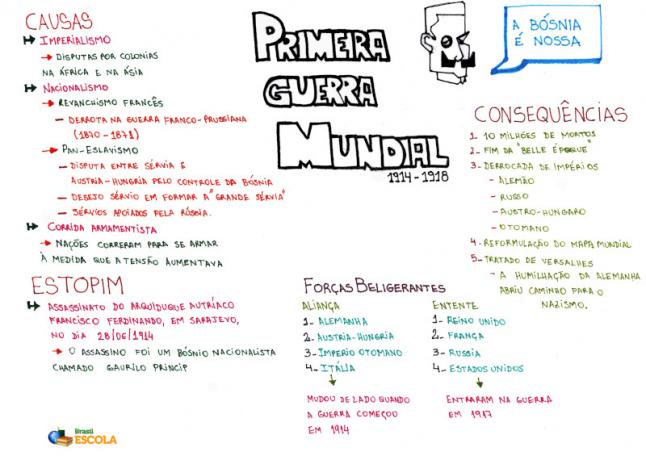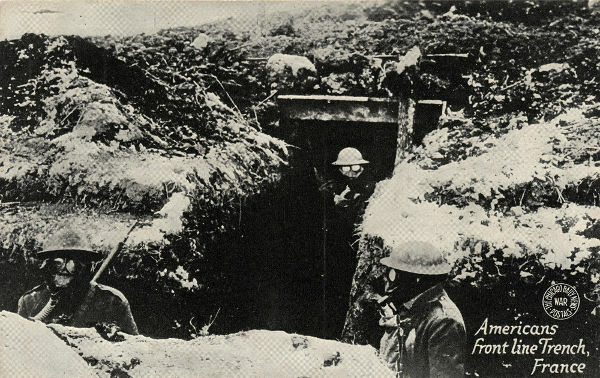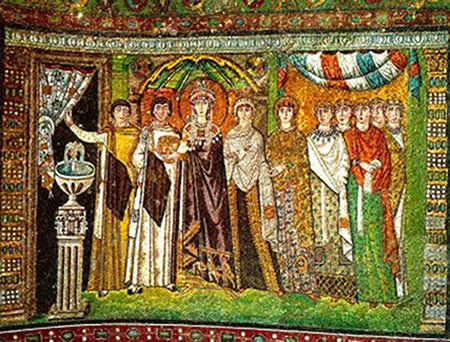THE First World War was a milestone in human history. It was the first war of the 20th century and the first conflict in state oftotal war – the one in which a nation mobilizes all its resources to enable combat. It lasted from 1914 to 1918 and was the result of the transformations taking place in Europe, which made different nations come into conflict.
The result of the First World War was a drastic trauma. A generation of young people grew up traumatized by the horrors of war. The battlefront, especially the Western one, was marked by the carnage experienced in the trenches and a balance of 10 million dead. The mishaps of the First World War contributed for, in 1939, a new war to happen.
Mind Map: World War I

* To download the mind map in PDF, Click here!
Causes
The causes of World War I are extremely complex and involve a series of non- solutions that have dragged on since the 19th century: economic rivalries, nationalist tensions, alliances military etc.
Overall, the main factors that contributed to the start of World War I were:
imperialist disputes;
nationalisms;
military alliances;
arms race.
At imperialist question, the focus can be on the fear that the rise of Germany has generated in nations like Russia, France and Great Britain. The Germans had gone through the unification process in the second half of the 19th century and, after that, they launched themselves in search of colonies for your country. This readily caught the attention of France, for example, which saw its interests being harmed by the German strengthening.
THE question of nationalisms involved different nations. Germany spearheaded a movement known as pangermanism. This nationalist movement served as an ideological support for the German Empire to defend its territorial expansion interests at the beginning of the 20th century. Pan-Germanism still expressed itself in economic issues, as the Germans intended to position themselves as the hegemonic economic and military force in Europe.
In the nationalist question, there was also the french revenge. This question involved the resentments that existed in France about the outcome of the Franco-Prussian War, conflict between Prussia and France in 1870 and 1871. The French defeat was considered humiliating, mainly for two reasons: the surrender being signed in the Gallery of Mirrors, at the Palace of Versailles, and the loss of Alsace-Lorraine. After the end of this conflict, Prussia proclaimed itself the German Empire.
The most complex nationalist question involved the Balkans, region in the southeast of the European continent. At the beginning of the 20th century, the Balkans were almost entirely dominated by the Austro-Hungarian Empire, which was in ruins because of the multiplicity of nationalities and separatist movements that existed in its territory.
The great tension in the Balkans involved Serbia and Austria-Hungary in the question concerning the control of Bosnia. Serbs fought for the formation of Greater Serbia and so they wanted to annex Bosnia to their territory (Bosnia was officially part of Austria-Hungary since 1908). This nationalist movement of Serbs was supported by Russia through the Pan-Slavism, ideal in which all Slavs would be united in a nation led by the Russian tsar.
Given this whole picture of tension and rivalries, the European nations got into a labyrinth of military alliances, which ended up being defined as follows:
Triple Entente: formed by Russia, Great Britain and France.
triple alliance: formed by Germany, Austria-Hungary, Ottoman Empire and Italy.
These military agreements included secret clauses for military cooperation if one nation was attacked by another opposing nation. Ultimately, all this hostility assured all the powers and heads of state in Europe that war was just a matter of time. For this reason, European nations have initiated a arms race with the objective of strengthening for the conflict that would occur.
What was needed for the war to start was a trigger, which happened on June 28, 1914, during the visit of Archduke Franz Ferdinand, heir to the Austrian throne, to Sarajevo, capital of Bosnia. The Archduke's visit was seen as a provocation and set in motion the nationalist groups that existed in Serbia and Bosnia.

Gavrilo Princip being arrested after committing the attack that caused the death of Francisco Ferdinando.
The result of the Archduke's visit was that Gavrilo Principal, a member of a Bosnian nationalist movement, armed with a revolver, got in front of the car carrying Francisco Ferdinando and his wife, Sofia. He opened fire, murdering both. The direct consequence of the act was a very serious political crisis that became known as July crisis.
As there was no diplomatic solution to the July Crisis, the final consequence was a chain of declarations of war. On July 29, Austria declared war on Serbia; on the 30th, Russians (in defense of Serbia), Germans and Austrians mobilized their armies. On Aug. 1, Germany declared war on Russia and on Aug. 3 on France. On the 4th, the UK declared war on Germany. It was the beginning of the First World War.
Countries involved
As mentioned in the text, the two groups that fought each other in World War I became known as triple alliance (the main forces were Germany, Austria-Hungary, Ottoman Empire and Italy) and Triple Entente (The main forces were Russia, Great Britain and France). In the case of Italy, the country was part of the Triple Alliance, but refused to participate in the war when it started. In 1915, Italy joined the Triple Entente.
Naturally, World War I was not just about the involvement of these countries, as several other nations were involved in the conflict. On the Entente side, countries like Greece, the United States, Canada, Japan and even Brazil entered the confrontation. On the Triple Alliance side, there was the participation of Bulgaria and other peoples and client states such as the Sultanate of Darfur.
Where did World War I take place?
The fighting of the First World War, for the most part, took place on the European continent. In Europe, the Western Front, in which the Germans fought against the French and the British, and the Eastern Front, in which the Germans fought against Serbs and Russians, stood out. During the war, there were also battles in the Middle East, that is, in the regions that were under the domination of the ottoman empire.
Do not stop now... There's more after the advertising ;)
Phases of the First War
Using the classification of the scholar Luiz de Alencar Araripe, the First World War can be divided into two major phases1. THE first phase became known as Movement War and it took place between August and November 1914. THE second level became known as trench warfare and took place between 1915 and 1918.
From the first phase of the war, the German plan of invasion of France by Belgian territory stood out, the so-called Schlieffen Plan. This plan was drawn up by the count Alfred von Schlieffen and it consisted basically of a maneuver to involve French troops and conquer Paris, the capital of France.
A few months after the French managed to prevent the Germans from conquering Paris, the second phase of the war began, characterized by the trenches. Trenches were underground corridors built to house soldiers and separate armies that fought each other. Often the distance between one trench and another was minimal.
Also access:Find out what life was like for soldiers in the trench
The space between the trenches was known as "nobody's land” and was filled with sandbags, barbed wire and everything else needed to ensure troop protection and to inform enemy troops approaching. During trench warfare, were used for the first time chemical weapons. The Germans initially used hydrochloric gas, which, over time, also came to be used by the French and the British. Finally, the hydrochloric gas was replaced by gasmustard.

American soldiers wearing masks to protect themselves from the chemical weapons used at the front.
Regarding the horrors of the Trench War fought on the Western Front, it is worth mentioning the account given by historian Eric Hobsbawm:
Millions of men faced each other on the parapets of trenches barricaded with sandbags, under which they lived like—and with—rats and lice. From time to time his generals sought to break the impasse. Days and even weeks of incessant artillery bombardment […] “softened” the enemy and sent him under the ground, until at the right moment you brought him men climbed over the parapet, usually protected by coils and webs of barbed wire, into “no man's land”, a chaos of grenade craters flooded with water, charred tree stumps, mud and abandoned corpses, and they advanced on the machine guns, which mowed them down, as they knew that would happen2.
On the Western Front, battles such as Verdun and Somme where fighting in the trenches caused the death of millions of soldiers on both sides. On the Eastern Front, the Germans managed to impose heavy defeats on the Russians in battles like the one in Tannenberg, ensuring great territorial achievements.
The violence of the war was also highlighted during the fighting that took place in Serbia. In the Middle East, the persecution that the Ottoman Empire promoted against the Armenians stood out, which led to the Armenian Genocide. World War I also saw air combat and a fierce dispute between Germans and British at sea.
In 1917, the United States, chaired by Woodrow Wilson, entered the war when a British vessel was attacked by Germans, killing more than a hundred Americans. That same year, the Russians, weakened by so many defeats and a very harsh economic crisis, withdrew from the war, and the Russian revolution consolidated socialism in the country.
World War I ended as a result of the breakdown of Triple Alliance forces. Bulgaria, Austria-Hungary and the Ottoman Empire surrendered, leaving only Germany. The war-torn German Empire also surrendered after a revolution broke out in the country and led to the end of the German monarchy. Those who implemented the republic in the country (the Social Democrats) opted for a armistice to end the war after four years.
Consequences
As a result of the armistice and the German defeat, in June 1919 the Treaty of Versailles. The signing of this treaty took place in exactly the same place where the French had ratified their defeat in 1871. This time, the defeated were the Germans, who signed a treaty that imposed very harsh terms on Germany.

Delegations gathered during the signing of the Treaty of Versailles in the Gallery of Mirrors, in 1919.
Germany lost all its overseas colonies as well as territories in Europe. She was forced to pay a huge fine, which dragged the country into an economic crisis unprecedented in its history. Its military forces were restricted to 100,000 infantry soldiers. The rigidity of the terms of the Treaty of Versailles is understood by historians as the door that opened the way for the emergence and growth of the Nazism.
The end of the war also marked the reconfiguration of the European map due to the disintegration of the German, Austro-Hungarian and Ottoman Empires. Several new nations emerged, such as Poland, Finland, Yugoslavia etc.
Second World War
The terms that the French and British imposed on Germany were regarded by historians as punitive peace. The aim was to weaken Germany in such a way that another war of the magnitude of World War I would not happen. British and French failed in this goal, as twenty years later a new war broke out in Europe: the Second World War.
Summary
World War I was a conflict that took place between 1914 and 1918, and the main war scenarios took place on the European continent. It was the result of numerous factors, such as economic rivalry, resentment of past events and nationalist issues. It was triggered by the assassination of Archduke Francisco Ferdinando and his wife, Sofia, in Sarajevo, Bosnia, in June 1914.
It spanned four years in two distinct phases: Movement Warfare and Trench Warfare. The last phase is best known for being the longest (from 1915 to 1918) and for having been effectively characterized by a high degree of mortality of the soldiers involved. The balance of the conflict was approximately 10 million dead and a completely transformed Europe.
___________________________
1ARARIPE, Luiz de Alencar. First World War. In.: MAGNOLI, Demetrius (ed.). History of Wars. São Paulo: Contexto, 2013, p. 332.
2 HOBSBAWM, Eric. The Age of Extremes: the brief 20th century 1914-1991. São Paulo: Companhia das Letras, 1995, p. 33.
By Daniel Neves
Graduated in History
(Cetred) At the end of World War I, a National Assembly was installed in Germany, which met in Weimar to prepare a new Constitution for the country. A new state was born there, called:
a) Holy Roman Empire.
c) German Confederation.
d) Democratic Republic of Germany.
e) Federal Republic of Germany.
(Avança-SP) Of the phenomena mentioned below, highlight the one that is considered to be the cause of the First World War.
a) The assassination of the Russian imperial family.
b) The end of African colonialism.
c) The emancipation of the Arab peoples.
d) Failure by Germany to comply with the Treaty of Versailles.
e) The assassination of Archduke Franz Ferdinand, heir to the Austrian throne.

